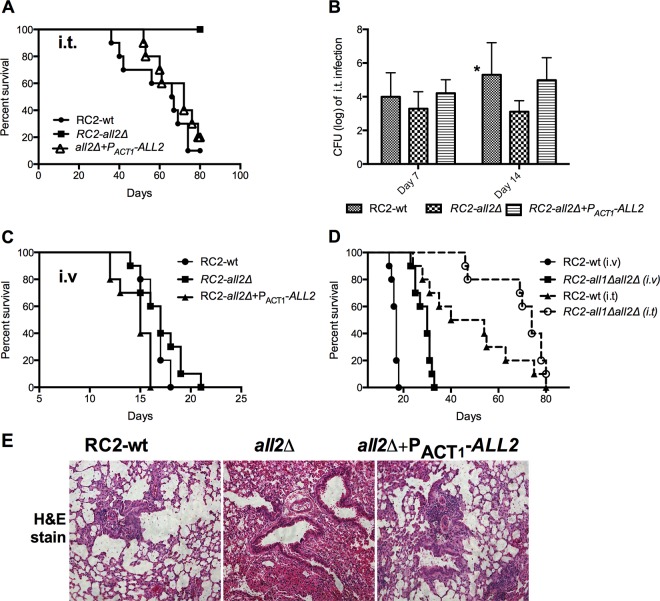FIG 3.
RC2-all2Δ mutants have attenuated virulence in a murine pulmonary infection model. (A) Mice infected i.t. with the mutant strain survived significantly longer than those infected with the wild-type or reconstituted strain (P = 0.0002). (B) Mice infected with 5 × 104 cells i.t. had comparable lung fungal burdens of log 3.9 ± 1.4, 3.2 ± 1.2, and 4.1 ± 0.8 for RC2-wt, RC2-all2Δ, and RC2-all2Δ+PACT1-ALL2 strain-infected mice, respectively, at 7 days postinfection. However, consistent with the survival difference, RC2-all2Δ strains had a lower lung fungal burden at 14 days postinfection (log 5.3 ± 1.9, 3.1 ± 0.6, and 4.9 ± 1.3 for wild-type, all2Δ, and all2Δ+PACT1-ALL2 strain-infected mice, respectively [P = 0.04]). (C) No difference in survival was noted in an i.v. infection model between the wild-type and RC2-all2Δ mutant strains. (D) The double mutant (RC2-all1Δall2Δ) was hypovirulent in both the i.t. and i.v. models. (E) Histopathology of lungs stained with hematoxylin and eosin (H&E) and infected with 104 cells was examined. On day 14, lung histology revealed that RC2-all2Δ-infected mice had a more pronounced host response, resulting in enhanced clearance of lung fungal burden compared to wild-type- and reconstituted strain-infected mice. Lower numbers of yeast cells and more inflammatory cells were observed in the alveolar spaces of RC2-all2Δ infected mice than for wild-type- and RC2-all2Δ+PACT1-ALL2-infected mice. An asterisk denotes a P value of ≤0.05.

